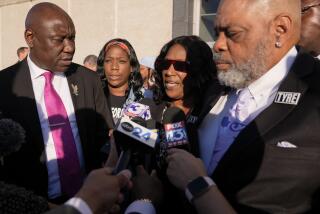Prosecution Rests Case in Nichols’ Sentencing Trial
- Share via
McALESTER, Okla. — Prosecutors rested their sentencing case Thursday in the murder trial of Oklahoma City bombing conspirator Terry L. Nichols after three days of testimony aimed at persuading jurors to give him the death penalty.
Members of victims’ families testified about the emotional, psychological and financial effect of the victims’ deaths. Defense attorneys will begin calling witnesses Monday to try to spare Nichols’ life.
The jury convicted Nichols of 161 counts of first-degree murder May 26 and heard from 65 prosecution witnesses in the sentencing phase. Judge Steven Taylor planned a hearing for today on prosecution motions to exclude certain defense witnesses.
Nichols is serving life in prison on federal charges for conspiracy and the deaths of eight federal agents in the April 19, 1995, bombing of the Alfred P. Murrah Federal Building, which killed 168 people.
Oklahoma prosecutors charged Nichols for the other 160 people who died and one victim’s fetus.
Prosecutors concluded their sentencing case with testimony from people who lost family members in the bombing.
Carla Wade, a broadcast journalist whose father, Johnny Allen Wade, was killed in the blast, said she experiences nightmares in which her father appears to her in various places such as airports and shopping centers. She said she wakes up disoriented and has to look at newspapers or a calendar to assure herself that it was only a dream.
She often recalls her father’s favorite saying: “Smile, kid. The world isn’t as bad as you think it is.”
Following her testimony, Nichols removed his glasses and appeared to wipe tears from his eyes.
Melissa Webster, a paramedic, said she and other ambulance crews treated 500 to 600 people at a triage station set up about a block from the federal building. As many as 250 were severely injured, she said.
“There were hundreds of people in the street and I didn’t see anyone who wasn’t bleeding,” she said.
Webster said she also treated children who had been in the nearby YMCA and were cut by shards of glass propelled like missiles by the explosion. “I don’t think there was anyone there who didn’t have lacerations to the face, the arms.”
More to Read
Sign up for Essential California
The most important California stories and recommendations in your inbox every morning.
You may occasionally receive promotional content from the Los Angeles Times.













